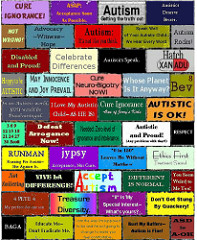And now, a topic near-and-dear to everyone’s heart: using the toilet.
Ask six different adults their opinions on toilet-training, and you’ll get six different opinions. You’ll even more than six opinions if any of them are parents, because a person’s expertise changes with each child, as each child seems to go through the whole process differently.
With any child, toilet training is an incremental process that has less to do with the willingness of the adult, and is dependent upon more than just the willingness of the child. Toilet-training children with developmental disabilities can certainly take much longer than with typical children, due to the number of factors affecting the whole learning process.
Toilet training is actually a very complex combination of factors. The child has to be able to do several things in sequence. A lot of children (of all sorts!) will get “hung up” on one or more points, thus delaying or even permanently hampering their ability to be come fully toilet-trained.
Consider the following:
1. The child must be able to be aware of having a full bladder or rectum (these are often acquired separately, with the child mastering one before the other);
2. The child must be able to be aware of the full sensation with enough time to get to the toilet and do everything else necessary before toileting;
3. The child must be able to consciously control both functions (start & stop);
4. The child must be able to undress independently;
5. The child must be able to manœuver themselves correctly onto the toilet seat and back off again;
6. The child must be able to wipe themselves adequately (and remember, it’s hard to dismount the toilet without getting the seat messy — this is tricky!);
7. The child must be able to re-dress independently;
8. The child must be able to wash their hands adequately.
It’s really helpful if the child doesn’t become distracted by some other event or random thought in the middle of the process (especially with boys who pee standing up, and can turn to look at something else…)
It’s also really helpful if the child can remember to flush the toilet, and do so without either freaking out at the noise, or becoming fascinated at watching any number of household objects go swirling into oblivion … ::sigh::
Some kids will take much longer to get all these things down. Every parent in the universe can tell stories of how their child[ren] got hung up at some part of that or another.
Not being toilet-trained isn’t the end of the world. There are, after all, diapers sold for adults for the simple reason that not everyone is fully able to have full control. These are no more “shameful” than are tampons and pads.
And then there’s the whole universe of situations outside of the home that can make toileting a far-from-consistent skill …
Something parents find is that their child is happily toilet-trained at home, but not elsewhere. This is very distressing for some parents, because (subconsciously) they feel that it is their reputations (ego) on the line – they’ve told everyone that their child is toilet-trained, and here is the child failing to do so. It seems to reflect badly on their truthfulness or their parenting skills, or damages their social standing among their peers.
It’s rarely about the parent, though.
When children can’t or don’t want to use other’s toilets, it may be a cognitive maturity thing (being able to generalise what is done at home with doing it elsewhere), it may be a “bashful bladder” issue, and/or it may be a sensory issue.
A lot of people don’t “get” these sensory issues. Allow a bit of autobiographical information here, if you will (don’t worry; nothing gross).
Different kinds of toilet seats may feel “wrong” — the U-shaped seats are uncomfortable for a small child because of their narrow hips. Or for example, I am cued to toilet on the convex ring seat, but when I encountered a totally flat seat, it felt a lot like a school chair seat!
Even worse is the cheap, industrial toilet paper used in schools and public restrooms. Or the strange toilet paper dispensers that issue small folded sheets or that won’t fully rotate. Or the soap dispensers that issue gritty powder or strange-smelling goo. (It’s interesting that if you talk to world travelers you’ll hear lots of stories about difficult toileting situations, and yet somehow many of those same adults would be annoyed if a child had similar difficulties when encountering a strange toilet.)
With acute olfactory senses, others’ bathrooms will also smell wrong (it is almost at the level of an animal instinct — you do not use someone else’s territory).
Public bathrooms are noisy and full of commotion, and again from the biological perspective, toileting is done in privacy because the animal is defenseless during the process.
Some of the hot-air hand dryers work at an amazing noise frequency that hurts the ears, especially when you are standing or seated nearby with your head at the same height. And who hangs all these sinks so high that small people and wheelchair users find them difficult to reach?
Other people’s home bathrooms may simply be full of distractions — they are full of interesting objects not contained at home that look different, smell different and work differently.
There are sometimes other factors at work that are not apparent; one year in primary school I kept getting re-occuring bladder infections. The pædiatrician said for me to quit taking bubble baths. Well, that helped a little, but the problem remained. My mother told me that I simply needed to go more often. “Simply” was difficult, because on weekends I would get so wrapped up in (hyperfocused upon) whatever fascinating thing I was working on that I couldn’t “hear” my physiological signals that I needed to go until I really, really needed to go.
“Simply” was even more difficult on weekdays, because my fourth-grade teacher was a new graduate who felt a strong need to be in control of her classroom, and letting the students get up at all times to go to the bathroom upset her routine and that control.
The bathrooms also smelled. I know, everyone says that school bathrooms smell. But my personal definition of “smelly” turns out to be quantitatively different than others’ “smelly”: stale sour body odors compounded with the intrusive artificiality of perfumes, aftershave, scented deodorant, cloying fabric softener, and hairspray; chewing gum and mints and candies; nauseating sting of cigarettes; abrasively floral room “deodorizer”; caustic bathroom sanitizers; various toileting odors including the muddy smell of used tampons and pads, the sharp sour odor of someone with intestinal upset, or ketosis odor of someone on a high-protein diet; institutional handwashing soap and brown paper towels; and general trenchant skunkiness of locker rooms. If it is a unisex primary school bathroom in the classroom or nurse’s office, then there is the sweet odor of small-boy urine as well. I found these odors to be so over-powering that I avoided the bathroom unless direly necessary.
It took months for my mother to understand the problem, because she had to ask me about school, actually take my answers seriously, and then take the enquiry further. This was because at the time, I totally lacked the understanding that she didn’t know what my class was like, and how the teacher was running the class. She simply assumed that if I was having a problem that I would be able to identify it, and know how to resolve it, including knowing what I needed to tell whom! (Sorry, that was too much social awareness for this nine-year old aspie kid.) Finally we got things sorted out, and my pædiatrician wrote my mother a note to pass on to my teacher explaining that I was prone to bladder infections and needed to go to the bathroom frequently, and was not merely trying to avoid schoolwork or whatever.
Other problems I later had with bathrooms in secondary high was the fact that the bathrooms were where the bullies hung out, who gave me no end of grief. I have some face-blindness issues (which I was unaware of then) so could not identify who those people were.
In truth, the whole toilet-training process is more about ability than willingness. The child has to be ready — and once they are physiologically ready, they are usually willing as well, provided they understand a benefit to moving from diapers to the toilet. Avoiding parental upset at still being in diapers is not necessarily a major driving force for some children, especially if parental annoyance has been an everyday part of the home landscape for a long time.
The end message here is that what a person is observing (as so many people do with autistics) is the end behaviour. What cannot readily be discerned, but is more important, is what causes the behaviours. If you are dealing with toilet issues, then remember that trying to modify the effect (that is the resulting behaviour) is less effective than to modify the cause of what is creating the behaviour! Figure out why the child is having difficulty and address that.
And yes, I’ve dealt with toileting issues from the parental end. Encopresis is not fun, but children do mature! I don’t know what my mother did to resolve the fecal-smearing problem (she’s no longer around to ask), but I grew out of that.
I even learned to tie my shoes, although that’s another story.








mcewen said,
16 January 2007 at 18:47
Thanks for the tips and perspective. Cheers
Joseph said,
15 January 2007 at 21:51
Good recap. I recently went through this with my son. He’s 5, classically autistic. Once we actually started training, it turned out to not be as hard or impossible as we thought it was going to be.
Before that we probably spent 6 months or so teaching him to sit and stay on the toilet. We put a table in front of it where he could paint. That worked pretty well.
We also noticed that he went and hid in a closet or behind a courtain when it was time for # 2. That indicated readiness.
The most important thing is realizing that you just have to go for it. There are going to be messes to clean, but how else is the child going to learn? The diapers need to come off completely.
Luckily, it turns out he could also hold it at night. We didn’t have problems in that area.
I hope that is helpful to someone reading.